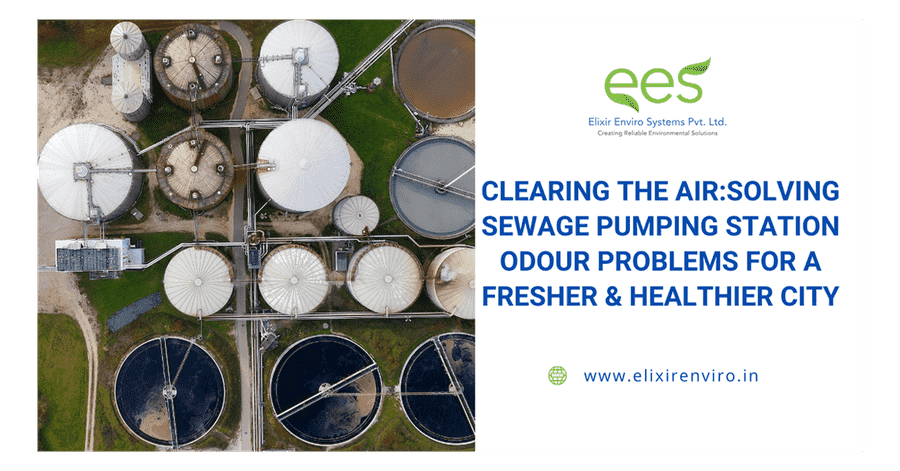
As urban areas continue to expand, the demand for efficient wastewater management systems grows with them. Sewage pumping stations are vital infrastructure elements that transport sewage from lower to higher elevations, making it possible to send wastewater to treatment facilities where gravity flow is not feasible. However, one of the most common — and often overlooked — challenges of sewage pumping stations is odour control.
Odours from sewage pumping stations are more than just an inconvenience. They are a significant environmental concern, a public health risk, and a factor that can negatively impact the social well-being of communities. In this blog, we will explore the causes of sewage pumping station odours, the challenges of managing them, technologies available for odour control, and how Elixir Enviro Systems is helping industries and municipalities solve these challenges sustainably.
Odour emissions are not just a public nuisance; they pose serious health and environmental risks:
Odour emission from sewage pumping stations happens because of the way they handle wastewater. Odour to become a problem, it must leave the wastewater and enter the air. This process, known as mass transfer, is driven by concentration differences—when there’s more of a compound in the water than in the air, nature pushes for balance, causing gases to be released. Ventilation and turbulence speed up this transfer, making the sewage pumping station prone to strong odors. While Henry’s Law predicts how much gas should be in the air, real-world factors like flow rates, temperature, and facility design create much more variability.
Let’s understand various factors contributing to odour emission from sewage pumping stations, drawing on various sources to ensure a thorough understanding.
Odour in sewage pumping stations primarily arises from the anaerobic decomposition of organic matter, leading to the production of hydrogen sulphide (H₂S) and other volatile organic compounds (VOCs). H₂S, known for its rotten egg smell, is generated by sulfate-reducing bacteria in conditions where oxygen is depleted, such as in stagnant sewage. This process is particularly pronounced in wet wells, where sewage accumulates before pumping, and in rising mains, where hydraulic residence time exceeds 6 hours. The decomposition is accelerated by warmer temperatures and stronger sewage, often seen during dry weather, which reduces dilution and increases organic content.
Sewage pumping stations are designed to collect and pump wastewater to treatment facilities, often against gravity, using wet wells and force mains. The wet well, where sewage is stored before pumping, is a critical area for odour production due to the potential for stagnation. When sewage sits for extended periods, anaerobic conditions develop, fostering H₂S production. The pumping action itself, involving turbulence, exacerbates odour emission by agitating the sewage and releasing trapped gases into the atmosphere.
The length of the force main, the pipe from the pump to the discharge, also influences odour. Longer force mains increase the residence time of sewage, allowing more time for anaerobic decomposition and H₂S production. Design guidelines for sewage works emphasize keeping force main lengths short to reduce dynamic head losses and odour production. This is particularly important at initial and design flows, where prolonged exposure can lead to significant gas buildup.
Trends in sewer system design, such as centralizing treatment and moving to separate sewer systems, can exacerbate H₂S problems. Centralization increases pumping distances, leading to more stagnant conditions and higher H₂S production, while separate systems lack rainwater dilution, increasing the risk of odour issues. These trends highlight the need for adaptive odour control strategies in modern wastewater management.
An interesting factor is trade effluent—wastewater from industries—which can add odorous compounds, making the smell stronger, especially in dry weather when sewage is more concentrated. Trade effluent, may itself be odorous or increase the strength of the sewage, leading to enhanced odour generation. This is particularly relevant in urban areas where industrial discharges are common.
Maintenance is another critical factor. Poorly maintained stations, with blockages or grease buildup, can lead to increased odour emissions. Similarly, control float switch problems can cause pumps to remain on, potentially agitating sewage excessively and releasing more gases. Regular maintenance, including clearing debris and ensuring proper operation, is essential to mitigate these issues, as advised in community guidance for living near pumping stations.
Environmental factors, such as temperature, play a role in odour intensity. Warmer seasonal temperatures increase odour generation, as bacterial activity accelerates. Additionally, the design of ventilation systems can affect how odours are dispersed. For instance, rooftop vents and mechanical ventilation are used to manage pressure and flow, but improper design can lead to odours reaching ground levels, especially under wind currents or temperature inversions.
Wastewater isn’t just water—it’s a complex mix of organic compounds, many of which have strong, unpleasant odours. As oxygen is depleted and anaerobic conditions take over, these odours intensify, creating a bigger challenge for treatment facilities.
Hydrogen sulfide (H₂S) is the main offender, notorious for its rotten egg smell. It forms when sulfate-reducing bacteria thrive in oxygen-starved conditions, often inside pipe biofilms and sludge layers. Factors like low oxygen, high organic content, and long retention times boost its production. Highly toxic at high levels, H₂S can be deadly, making its control a top priority.
Beyond H₂S, other sulfur-based compounds—mercaptans, dimethyl sulfide, and dimethyl disulfide—add to the stench. These compounds are even trickier because they don’t dissolve as easily in water. High-energy areas like junction chambers, mixing tanks, and dewatering processes release them in full force, making odour control a challenge.
While ammonia isn’t as pungent as sulfur compounds, it can still be a problem, especially in solids processing. Dewatering, lime stabilization, and composting can trigger ammonia emissions, sometimes mixed with fishy-smelling amines. Anaerobic digestion and high-temperature processes further intensify these odours.
Odour isn’t just about sulfur and nitrogen. Wastewater also contains volatile organic compounds (VOCs), aldehydes, ketones, and carboxylic acids, which contribute to its distinct, unpleasant scent. While not always the main culprits, they can make odour control even more complex.
Understanding these odour sources is key to managing them effectively.
Effective design is paramount to minimizing odour emissions, and several strategies can be implemented based on engineering guidelines and best practices. The following sections outline these considerations
The station’s location and layout can also influence odour impact:
One of the most effective ways to reduce odour is to minimize the time sewage spends in the pumping station, particularly in the wet well. This can be achieved through:
The type and operation of pumps can influence odour emissions:
The wet well’s design can directly impact odour control:
Liquid side treatments focus on preventing odour formation in the wastewater itself, targeting the root cause by maintaining aerobic conditions or neutralizing odorous compounds. Chemical treatment can be integrated into the design to prevent odour-causing gas formation:
In the previous point we discussed the possibilities and options to avoid odour emissions to the gas phase. Generally, without a proper air treatment, it is hard to operate the pumping station, especially since the odour threshold of the compounds causing odour are very small making it detectable at very low concentrations. So, odour emission is unavoidable in most cases and therefore odour control equipment is absolute necessary. The Air side treatments focus on capturing and treating odorous air to prevent its release into the environment. The air side treatment includes Containments, Ventilation and Odour Control Units (OCUs).
Preventing odours from escaping into the environment requires robust containment measures:
Ventilation is critical for removing odorous air from the wet well. Design considerations include:
1. Biofilters & Biotrickling FIlters
Use microorganisms to biologically degrade odorous compounds in the air. They can remove 99.9% of H₂S, ammonia, and other odours. They perform best with stable airflow and are eco-friendly, requiring no chemicals and have low operating costs.
2. Activated Carbon Adsorption Units
Activated carbon units are compact and effective at adsorbing odour-causing gases, particularly VOCs and H₂S. These systems are suitable for locations where space is a constraint and where moderate odour loads are encountered. Regular carbon replacement is required based on load.
Wet scrubbers use chemical solutions based on the type of compounds to be removed from the air stream. Chemicals such as sodium hydroxide or chlorine-based compounds to neutralize hydrogen sulfide and acids to remove ammonia. Therefore, it is generally called Acid and Alkali Scrubbers and are suitable for high contaminant levels.
4. Thermal Oxidation
Burns odorous air at high temperatures, though less common for pumping stations due to energy costs.
Effective odour control doesn’t end with treatment — continuous monitoring is key:
At Elixir Enviro Systems, we understand the complexity of sewage odour control and offer customized solutions that combine efficiency, sustainability, and long-term reliability. Our services include:
✅ Biofilter & Bioscrubber Design & Installation – Tailored systems with optimized media selection for maximum efficiency.
✅ Scrubber Systems – Wet and dry scrubber solutions for handling high-concentration odour streams.
✅ Odour Control Units (OCUs) – Different modular solutions combining biofiltration, carbon adsorption, and chemical scrubbing are available based on the client requirement.
✅ Odour Impact Assessment and Modeling – Using advanced simulation tools to predict odour dispersion and community impact.
Odour control in sewage pumping stations is not just a regulatory requirement — it’s a commitment to public health, environmental stewardship, and community welfare. By leveraging advanced technologies and proactive monitoring, municipalities and industries can effectively mitigate odour issues and create more liveable urban environments.
At Elixir Enviro Systems, we are proud to be part of that mission, offering reliable, innovative, and sustainable odour control solutions that protect both people and the planet.




